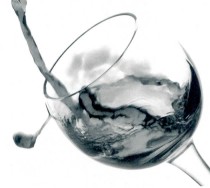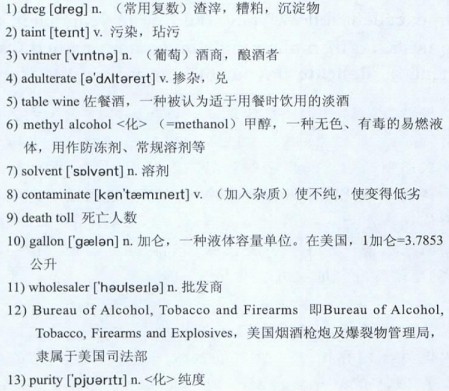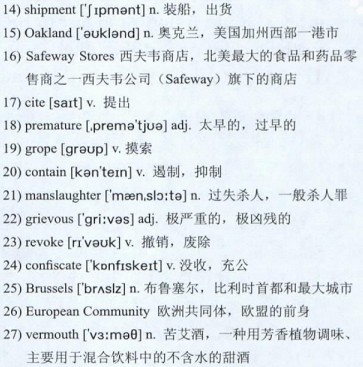The 1)Dregs of a Deadly Scandal
文字难度:★★☆
 In 1986, a big 2)tainted-wine scandal happened in Italy. More than five weeks after a number of 3)vintners were first discovered to be 4)adulterating their low-priced 5)table wines with 6)methyl alcohol, which is more commonly used as paint 7)solvent, at least 22 Italians had died and about 90 others were hospitalized after drinking the8)contaminated product.
In 1986, a big 2)tainted-wine scandal happened in Italy. More than five weeks after a number of 3)vintners were first discovered to be 4)adulterating their low-priced 5)table wines with 6)methyl alcohol, which is more commonly used as paint 7)solvent, at least 22 Italians had died and about 90 others were hospitalized after drinking the8)contaminated product.
As the 9)death toll rose, the Italian government listed some 300 labels as suspect, prompting worldwide concern and threatening the country’s $953 million wine-export trade.
In the U.S., where some 73 million 10)gallons of Italian wine were imported every year and sales had been booming, federal officials warned 11)wholesalers and importers not to distribute any Italian wines until samples could be tested for methyl alcohol. Then the 12)Bureau of Alcohol, Tobacco and Firearms(BATF) advised drinkers not to touch Italian wines until tests showed that they were not contaminated. The Italian embassy emphasized that the only products that had so far been discovered to be tainted were cheap varieties that sold in Italy for about $1.50 per gallon.
Italy’s commercial counselor in Washington, Gerardo Carante, said that only six of the Italian firms whose wines were suspected of being contaminated had shipped products to the U.S. Nonetheless, BATF Director Stephen Higgins announced that all Italian wine entering the country would have to carry the certificate of 13)purity that the Italian government had begun issuing for bottles cleared for export. 14)Shipments that left Italy before the Roman government had begun requiring the certificates would be prohibited from entering U.S. markets.
The BATF’s warnings prompted many wine sellers across the nation to remove Italian products from their shelves immediately. Among them was 15)Oakland-based16)Safeway Stores, which sold wine in some 1,200 supermarkets and 104 Liquor Barn stores. Said Safeway Spokeswoman Felicia del Campo: “Nobody could assure us that none of the adulterated wines had reached the U.S.” Many other retailers resisted the move, however, pointing out that they did not sell low-grade products, or 17)citing confidence in their own distribution systems. Said Louis Iacucci, president of Goldstar Wines & Spirits of Queens, N.Y., the nation’s single largest retailer of Italian wines: “The scare was 18)premature, and it has done a lot of harm to some of the great winemakers of the world.”
Meanwhile in Rome, the Italian government 19)groped to 20)contain the disaster. At least twelve vintners were arrested on charges ranging from 21)manslaughter and22)grievous bodily harm, to criminal association and illegal adulteration of food. Prime Minister Bettino Craxi announced that any vintner guilty of adulterating wine could have his winemaking license 23)revoked and his profits and equipment 24)confiscated in addition to facing criminal charges. Agriculture Minister Filippo Pandolfi flew to 25)Brussels, where he tried to convince leaders of the 26)European Community that no ban on Italian imports was necessary.
Despite these efforts, there was no doubt that Italy had suffered a traumatic blow. In Denmark, where a 6,613-gallon shipment of cheap Italian 27)vermouth was found to contain dangerous amounts of methyl alcohol, officials issued a ban on all Italian wines. West Germany imposed border controls requiring Italian wine imports to be cleared by government chemists. And in France, the government seized 4.4 million gallons of suspect wine and dumped at least 1.3 million gallons. Clearly, it would be a long time before the world’s consumers fully recovered their confidence in one of Italy’s best-known and most widely distributed products.


